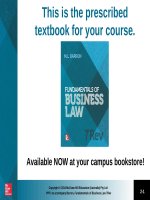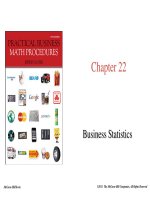Lecture Practical business math procedures (10/e): Chapter 2 - Jeffrey Slater
Bạn đang xem bản rút gọn của tài liệu. Xem và tải ngay bản đầy đủ của tài liệu tại đây (505.03 KB, 21 trang )
Chapter 2
Fractions
McGrawHill/Irwin
©2011 The McGrawHill Companies, All Rights Reserved
#2 Fractions
Learning Unit Objectives
LU2.1 Types of Fractions and Conversion
Procedures
1. Recognize the three types of fractions
2. Convert improper fractions to whole or
mixed numbers and mixed numbers to
improper fractions
3. Convert fractions to lowest and highest
terms
22
#2 Fractions
Learning Unit Objectives
LU2.2 Adding and Subtraction of Fractions
1. Add like and unlike fractions
2. Find the least common denominator
(LCD) by inspection and prime numbers
3. Subtract like and unlike fractions
4. Add and subtract mixed numbers with
the same or different denominators
23
#2 Fractions
Learning Unit Objectives
LU2.3 Multiplying and Dividing Fractions
1. Multiply and divide proper fractions and
mixed numbers
2. Use the cancellation method in the
multiplication and division of fractions
24
Types of Fractions
Proper
Numerator
1, 1, 1, 4, 18
4 2 12 7 55
Denominator
25
Proper fractions have a
value less than 1; its
numerator is smaller
than its denominator.
Types of Fractions
Improper
Numerator
Improper Fractions
have a value equal to or
greater than 1; its
numerator is equal or
greater than its
denominator.
Denominator
26
14, 7, 15, 22
14 6 14 19
Types of Fractions
Mixed numbers are the sum of a
whole number greater than zero
and a proper fraction
Mixed Numbers
5 1, 9, 7, 5, 9
5
8
33 139
6 10 8 6 11
27
Converting Mixed Numbers to Improper
Fractions Mixed Numbers
3 Steps
1. Multiply the denominator
of the fraction by the
whole number.
2. Add the product from Step
1 to the numerator of the
old fraction.
3 Place the total from Step 2
over the denominator of
the old fraction to get the
improper fraction.
28
6 1
8
(8 x 6) = 48
(8 x 6) = 48
48 + 1 = 49
49
8
Reducing Fractions to Lowest
Terms by Inspection
Find the lowest whole
number that will divide
evenly into the
numerator and
denominator
29
24 24 / 6 4
=
=
30 30 / 6 5
Finding the Greatest Common Divisor
Step 1. Divide the
numerator into the
denominator
Step 2. Divide the
remainder in Step 1 into
the divisor of Step 1
210
Step 3. Divide the
remainder of Step 2 into
the divisor of Step 2.
Continue until the
remainder is 0
24
30
1
24 30
24
6
4
6 24
24
0
24 / 6 4
=
30 / 6 5
Adding Like Fractions
• Add the numerators
and place the total over
the denominator
1 4 5
+ =
7 7 7
5 6 11 2
+ =
= 1
9 9 9 9
211
• If the total of your
numerators is the
same as your original
denominator, convert
your answer to a
whole number; if the
total is larger than
your original
b
denominator, convert
your answer to a
mixed number
Least Common Denominator (LCD)
• The smallest nonzero
whole number into
which ALL
denominators will
divide evenly.
What is the least
common
denominator?
212
3 5
+
7 21
7
42
21
Adding Unlike Fractions
4 Steps
1. Find the LCD
2. Change each fraction to a
like fraction with the
LCD.
3. Add the numerators and
place the total over the
LCD.
4. If necessary, reduce the
answer to lowest terms.
24 + 9 + 8 + 6 = 47
72 72 72 72 72
213
1 1 1 1
+ + +
3 8 9 12
Subtracting Like Fractions
• Step 1 Subtract the
numerators and place
the total over the
denominator
• Step 2 If necessary,
reduce the answer to
lowest terms
9 1 8 / 2 4
=
=
10 10 10 / 2 5
214
Subtracting Unlike Fractions
Step 1. Find the LCD
Step 2. Raise the fraction to
its equivalent value.
Step 3. Subtract the
numerators and place the
answer over the LCD.
Step 4. If necessary, reduce
the answer to lowest
terms.
215
5 2
8 64
5 40
8 64
2 2
64 64
38 = 19
64 32
Subtracting Mixed Numbers
When Borrowing is Not Necessary
Step 1. Subtract fractions,
making sure to find the
LCD.
Step 2. Subtract whole
numbers.
Step 3. Reduce the fractions
to lowest terms.
216
6 1 4
6
2 8
3 3
8 8
1
6
8
Subtracting Mixed Numbers
When Borrowing is Necessary
Step 1. Make sure the
fractions have the LCD.
Step 2. Borrow from the
whole number.
Step 3. Subtract whole
numbers and fractions.
Step 4. Reduce the fractions
to lowest terms.
217
3 1 2 6
3
2
2 4 4
1 3 3 3
1
1
4 4 4
3
1
4
Multiplying Proper Fractions
Step 1. Multiply the
numerator and the
denominators
Step 2. Reduce the answer to
lowest terms
218
5 1 4 20 10
x x =
=
1 6 7 42 21
Multiplying Mixed Numbers
Convert the mixed
numbers to
improper
fractions
Multiply the
numerator and
denominators
1
1 1 7 3 7 1
= =3
2
X 1 = X
3 2 3 2 2 2
1
219
Reduce the
answer to
lowest terms
Dividing Proper Fractions
Invert (turn
upside down)
the divisor (the
second fraction)
Multiply the
fractions
.
1 2 1 3 3
= X =
.
8 3 8 2 16
220
Reduce the
answer to
lowest terms
Dividing Mixed Numbers
Convert all mixed
numbers to
improper
fractions
Invert the divisor
and multiply
3 5 35 6 105 3
X 2 =
=3
=
X
8
4 6 4 17 34 34
221
Reduce the
answer to
lowest terms









